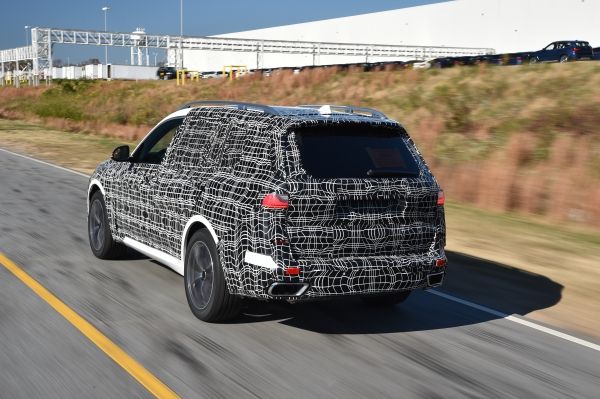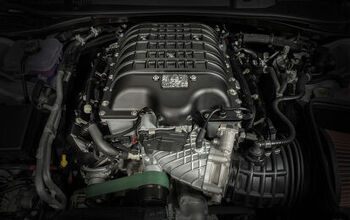As Spartanburg Slowly Births the BMW X7, an Ever-growing Pool of Buyers Awaits

It certainly feels like BMW is taking its sweet time getting the full-size, three-row X7 to market, but the automaker assures us it’s almost here. Announced yesterday, pre-production models are now rolling off BMW’s Spartanburg, South Carolina, assembly line — a major step in a product timeline that began in 2014.
Offering up an all-important third row and front end styling that’s sure to spark debate (this year’s X7 iPerformance concept set a high bar for controversy and grille size), the production model should be ready for a late 2018 debut. In the meantime, certification drudgery and copious amounts of hot and cold weather testing awaits.
As the sole member of the Big German Three without a three-row SUV (SAV in BMW parlance), the X7 is a much-needed vehicle, and not just because the automaker wants more high-margin vehicles to fund its electrification efforts. True, the new car market is contracting, but big premium utility vehicles sell.
From what BMW is willing to show us, the X7 — like the concept that preceded it — shouldn’t want for airflow through the front fascia. It was a big grille before, and it remains one now. A large, wraparound lower opening underscores the brand’s signature twin kidneys, which, unlike those found on all other X-models, are fused in the middle. The headlights are not nearly as narrow.
The X7 rides atop BMW’s CLAR modular platform, and buyers of the 2019 production model should expect a range of engine choices, as well as a likely hybrid option.
By adding the X7 to its Spartanburg assembly plant, BMW expects the factory’s workforce — which currently stands at 9,000 — to swell by a further 1,000 employees over the next few years. Spartanburg, Bimmer’s largest plant, builds the X3, X4, X5, and X6.
But what does the market hold for the X7? If sales of the model’s future competitors are any indication, Bimmer won’t regret spending the cash needed to make the X7 a reality. Three-row premium SUVs are a license to print money.
With one month left to go on 2017’s sales calendar, Audi’s Q7 has already surpassed 2016’s record U.S. sales volume. Through the end of November, sales are up 22.8 percent.
Mercedes-Benz soldiers on with its GLS class, formerly the GL. Year-to-date, GLS sales in the United States are up 7.6 percent, with the model poised to break last year’s record volume.
Over at Lexus, the brand can’t get enough three-row utility vehicles. The aging GX and range-topping LX simply aren’t enough to satisfy the automaker’s thirst for volume, so there’s a new three-row variant of the midsize RX coming for 2018. Still, GX sales are up 10.1 percent, year-to-date, with the model’s on track for its best sales showing in 12 years. Sales of the LX grew 8 percent in 2017.
As Infiniti prepares a new QX50 and introduces a refreshed QX80 flagship, the three-row QX60’s sales are down 2.2 percent, year-to-date. It’s worth noting that 2016 was the model’s best sales year since its 2013 model year introduction.
Suffice it to say there’s buyers waiting for the X7.
[Images: BMW Group]

More by Steph Willems
Latest Car Reviews
Read moreLatest Product Reviews
Read moreRecent Comments
- Jbltg The more time passes, the more BMW's resemble Honda. zzzz
- VoGhost Doubling down on the sector that is shrinking (ICE). Typical Nissan.
- Dwford I don't think price is the real issue. Plenty of people buy $40-50k gas vehicles every year. It's the functionality. People are worried about range and the ability to easily and quickly recharge. Also, if you want to buy an EV these days, you are mostly limited to midsize 5 passenger crossovers. How about some body style variety??
- SCE to AUX The nose went from terrible to weird.
- Chris P Bacon I'm not a fan of either, but if I had to choose, it would be the RAV. It's built for the long run with a NA engine and an 8 speed transmission. The Honda with a turbo and CVT might still last as long, but maintenance is going to cost more to get to 200000 miles for sure. The Honda is built for the first owner to lease and give back in 36 months. The Toyota is built to own and pass down.




































Comments
Join the conversation
Wow, that front end is hideous. Is it time for BMW to get the Old Yeller treatment?
"As the sole member of the Big German Three without a three-row SUV (SAV in BMW parlance), the X7..." The X5 is available with a third row. Mine has one, and while only suitable for kids, it does come in handy at times. . .